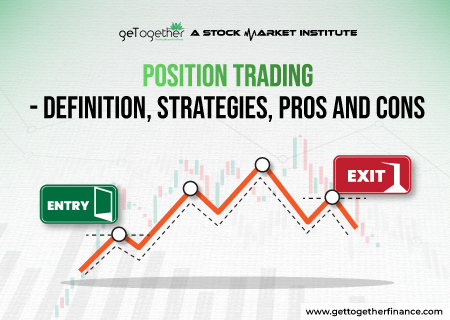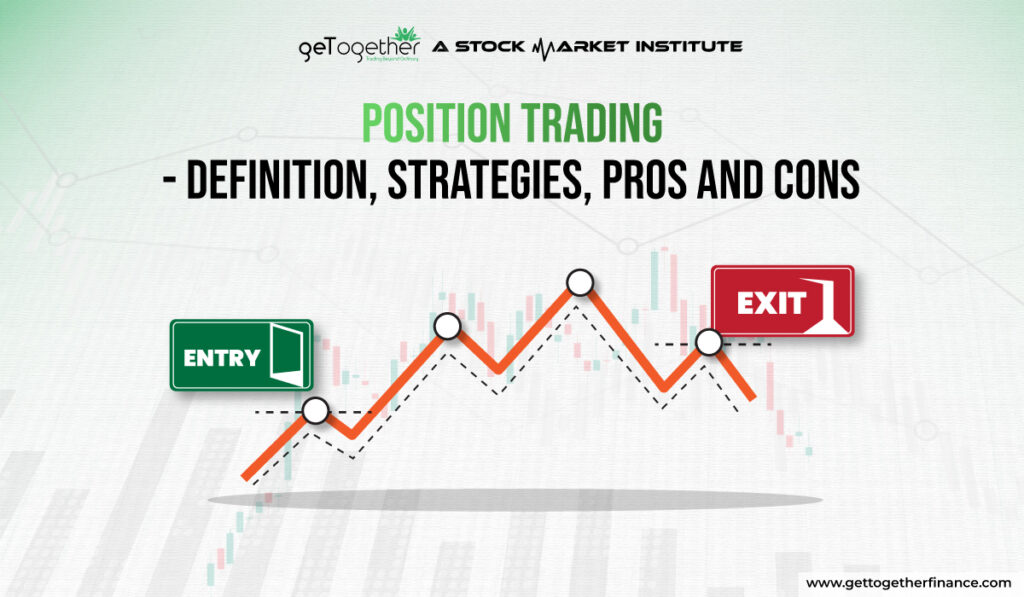Position Trading- Definition, Strategies, Pros and Cons
- June 20, 2024
- 1220 Views
- by Manaswi Agarwal


You must have observed that traders often undergo several trading strategies according to their best suited trading style. Position trading is one such trading strategy used by the traders which is similar to long term investment approach in which they hold their positions for extended periods i.e. from several weeks to months. Positional traders hold their assets with an expectation of increase in prices with time. Let us explore in depth about position trading and its several strategies.
What is Position Trading?
Position trading is a strategy used by the traders wherein they hold their positions for an extended period where they expect an increase in the asset prices. They hold their position for several weeks or months and only buy and hold investors hold their positions longer than positional traders. Short term fluctuations do not affect traders as they often look at the bigger picture of the market. They look at the long term performance of the market instead of making quick profits from scalping or other trading strategies. These traders are similar to investors but their holding period is less than an investor.
Position Trading Strategies

As we already know about the benefits of positional trading, let us learn some of the common positional trading strategies that could help you execute positional trades in an effective way:
Support and Resistance
Support and resistance is one of the technical analysis strategies that allow traders to visualize the price action of a stock. Support level constitutes the lower limit of price where the resistance level consists of the upper level of the stock. It is identified by the historical data of charts that are taken into account by traders to predict future price movements.
After a breakout of the resistance, previous support and resistance levels help to understand the price moves. With the help of historical data, traders can identify their entry and exit levels as per the analysis of support and resistance levels.
Pullback and Retracement Trading Strategy
Pullbacks are referred to short moments where market correction or reconciliation takes place in an upward trend or vice versa. Traders keep an eye on a pullback in the market to buy at low prices when the prices dip. Traders make their positions strongly based on the trend, so they are required to take accurate measures to avoid risks of trend reversal. It is one of the useful strategies for traders as they can enter the market at more favorable prices while minimizing their risks by setting stop loss orders.
Trading Breakouts
Breakout trading strategy is associated with support and resistance levels wherein the traders wait for the price to cross these levels and give a breakout either upwards or downwards. As per the breakout, traders enter in long or short positions. It requires experience to understand these types of trades which are to be taken after taking proper risk measures.
Demand and Supply Theory

After studying all the common strategies that are already used by positional traders, here comes the demand and supply theory. The stock market works on the demand and supply of a particular stock if a stock is in demand, the price potentially increases and vice versa. According to this theory, traders can make their entry at the bottom levels from where the prices start moving. It tells the traders to make their positions when the price reaches the levels of the demand zone.
Traders do not have to wait for breakout points to enter the position at such high prices increasing the efficiency of demand and supply theory. Not only this, traders can efficiently manage their risks by creating a strong trading plan as explained in the GTF elementary course.
Demand and supply theory is used to understand the overall price action of a stock based on which a trader can enjoy each rally in the stock. Advanced technical analysis includes the top down approach according to which overall price action of a stock is analyzed as per the demand and supply zone. If the price enters in the supply zone, then it is highly expected that the price will fall down from where a short position can be traded. You can learn about this strategy in depth from GTF – Trading in the zone course.
Advantages of Positional Trading

Position trading is one pragmatic approach used by the traders where they can earn substantial returns within several months. There are several trading approaches such as swing trading, day trading, scalping, etc. but position trading offers many advantages which includes:
Long Term Plan
Positional trades are executed with a long term approach with a view that asset prices move significantly in the long run. This is why traders take advantage of long term trends in the market which results in generating substantial gains over time.
Reduced Short Term Risks
Short term fluctuations in the market are not a part of concern for positional traders because the positions are held for several weeks or months with an aim of capitalizing substantial asset price movement in the long run. Positional trading becomes less risky than swing trading and day trading as it involves long term perspectives.
Reduced Stress
Positional traders have a long term outlook and are less vulnerable about market manipulations. It is less stressful as the frequency of monitoring the market reduces. This strategy allows traders to have more flexibility in their trading schedule and be convenient with their working instead of stressing about the price movements.
Less Transaction Costs
Positional traders are not involved in regular trading such as swing trades or day trades which reduces the cost of position trading. Therefore, position traders can earn higher profits after paying commission and fees.
Disadvantages of Position Trading

Despite of the several advantages of positional trading, there are some cons of holding positional trades and a trader must be aware of those risks and disadvantages, let us get to know them in detail:
Opportunity Cost
Traders may have to incur opportunity cost while holding positional trades. Opportunity cost refers to the cost that is incurred by a trade when a higher potential trade is missed out as the funds were blocked in a positional trade. Traders can often miss out on short term trading opportunities that could have offered big returns.
High Capital Requirement
Positional traders have a high amount of capital to sustain the market fluctuations while maintaining a diversified portfolio. In position trading, traders are required to maintain their margin requirements to sustain potential losses.
Limited Trading Opportunities
In position trading, traders are involved in limited trading approaches which restrict their opportunities for trading and hence are not exposed to a variety of trading opportunities. Position traders cannot pick every trade because their trades are based on long term perspectives.
Market Volatility
Positional traders are exposed to long term market risks as they hold their positions for an extended period. Sometimes, market volatility because of unexpected news or events can result in potential losses to the trader.
Emotional Challenges
Holding trades for a long term is emotionally challenging for traders, holding for a long period requires discipline and patience to avoid impulsive decision making.
Also Read: Flash Trading
Wrap It Up…
Short term investors or traders execute position trades wherein they hold their trades for an extended period with a long term perspective. Demand and supply helps you to accurately execute your positions and gain maximum profits. You can learn the same by enrolling in GTF – Trading in the zone course which is a quite powerful concept and is adopted by many traders.
FAQs
What is Positional Trading?
Positional trading is a kind of investment approach used by traders where they enter in a position for an extended period of time. Usually positional traders hold their trades for several weeks or months.
What are the benefits of positional trading?
Position trading offers several benefits to traders such as: increase capital over long term, less transactional costs, reduces stress and others.
How long to hold positional trades?
You should hold the positional trades as per the strategy that you have adopted and the targets planned to achieve. There is not a specific period; however, generally these trades are kept for several weeks or months.
What is the strategy of Positional Trading?
A demand and Supply theory is one of the most effective strategies that help traders to identify their entry or exit positions.



 Instagram
Instagram 
